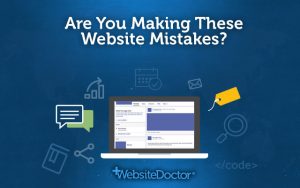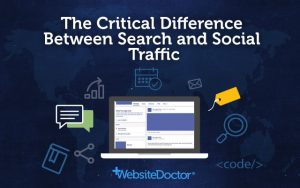Like most business owners, you want to increase your website traffic.
There’s one simple but crucial concept you need to be aware of while you’re doing that.
You already know that your traffic is made of up individual people, all with different needs, knowledge, mindsets and environment.
But the important thing is how it changes your marketing and the specific actions you take when you’re working on increasing website traffic.
A lot of people divide website visitor traffic into two “buckets”, paid and unpaid.
That’s not a really useful division as it doesn’t tell us a lot about what the web visitor is looking for or might respond well to.
However, there’s a hugely useful division between search and social traffic, and it’s really obvious when you think about it:
- visitors who come from searches are looking to solve a specific problem
- visitors who come from social networks are usually browsing
“I want to fix this problem so I can get on with my day!”
Think about the last time you googled something.
It might have been looking for a business phone number, or a movie showing time, or some recipe ingredients, or an error message. In every case you wanted to figure out how to do something (call the business, plan your movie night, cook that meal or make that error go away).
“I’m just killing time, waiting for Jordan to arrive…”
Think about when you were last on Facebook.
If you’re like most people, you were browsing down through your stream, you probably watched the start of a video or two, hit like on couple of a funny images, and got distracted by an interesting article or post and started reading.
Ok, so here’s the point: people on search are looking for a solution to a problem.
If you present a solution to their specific problem, it’s like putting a meal in front of a hungry person.
However, people on social are totally different. They’re in that browsing, “killing-time” mode.
And not only that, but they’re doing that in an environment you have no control over:
-> they’re in the queue in the supermarket
-> they’re in a bar waiting for their friend to come back from the ‘powder room’
-> they might even be in the car stopped at the traffic lights!
If you want to reach these people, you have to interrupt that stream by piquing their interest, getting them curious about whatever you’re offering.
That means a using straight-up sales pitch won’t work for social visitors in the same way that it would for “search mode” visitors.
(Incidentally, this is why Google’s worth is around twice that of Facebook)
The Takeaway
The first thing this can help you with is tweaking your social media activity, both paid and unpaid, to increase your website traffic.
If you’ve got a Facebook Page or Twitter or Instagram, think about creating content that arouses interest and curiosity.
That will hook the more “browsing mode” viewers into checking it out.
If you’re doing Facebook ads (and you should – more on this later), then go check your campaigns.
Are your ads designed to pique interest? Or are they a snorefest — like mine were when I started!
And next, if they are interested, how can you ensure that they come back to your site later?
(Because the light is about to go green, their friend has arrived, or the shopper in front is gone.)
Around 97% of visitors to a website visit once and never come back. (Source: your Google Analytics)
Stay tuned and I’ll talk about how to counter *that* problem in the next article.

 What stays the same?
What stays the same?



